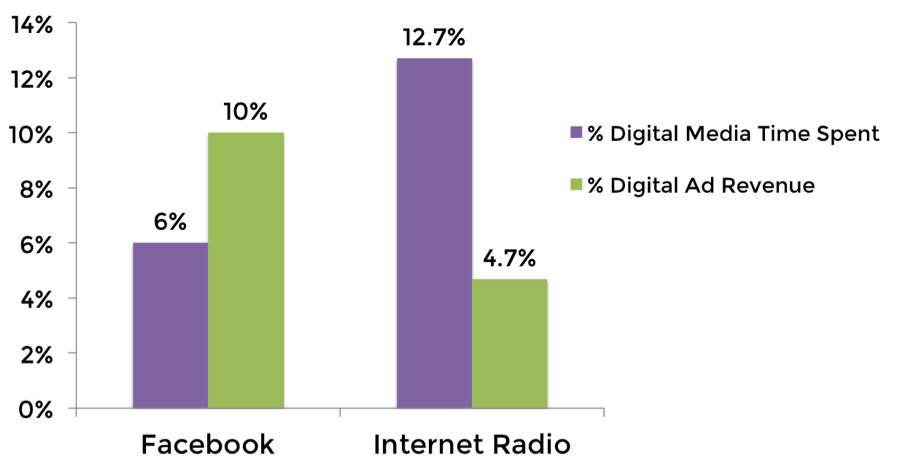Last month, I made an industry conference presentation on creating a great content interaction experience for mobile audio. The thesis was simple. It is not sufficient to deliver a great content consumption experience for mobile users. Consumers interact on mobile with a frequency and intensity that is simply absent in a desktop environment. You must produce a mobile user experience that considers both consumption and interaction to have a truly exceptional digital media product today.
The $4.7 Billion Penalty
So what is the penalty for falling short on the content interaction experience? For Internet radio and music streaming services it will be about $4.7 billion this year. Facebook captures digital ad dollars at a rate that is 67% higher than time spent with the app would indicate. It took in about 10% of digital ad spending last year despite only capturing 6% of digital media consumption time. MarketingLand calls this over-indexing and it delivered $2 billion in extra revenue to Facebook in 2014. By contrast, digital audio under-indexes. In 2015, it is expected to capture 12.7% of media consumption time in the U.S., but bring in only 4.7% of digital ad spending.

Both Facebook and Internet radio deliver great content consumption experiences. Their large audiences and the rapid growth for the latter attest to a favorable consumer experience. In fact, you might claim that Internet radio and streaming services do a better job on the content consumption experience since they command twice as much consumer attention as Facebook.
However, Facebook far exceeds Internet radio in one critical area – the content interaction experience. Content interaction is a key driver for ad spending. When consumers are interacting with sponsored content and advertisements, marketers are more likely to allocate budgets because performance matters. Facebook drives measurable actions that allow brands to see the effectiveness of their campaigns.
Audience + Performance Drive Ad Spending
There is no doubt that ad dollars follow audience. When ad-supported Internet radio and streaming services had little audience this might have explained under-indexed ad spending. However, that is no longer a problem. Internet radio is now accessed each month by over half the U.S. population. The channel has reach but ad dollars are not growing as fast as audience. The likely culprit is a lack of measurable performance – which means a lack of interaction.
How do we know interaction matters in digital ad spending? Look at digital advertising prior to Facebook. Clickable banners created the industry by showing consumer actions driven by display ads. Similarly, the growth in search advertising was also driven by consumer actions. The audience was there and advertising spend grew quickly around measurable interaction. The question for the digital audio category, is what interaction method can deliver sufficient performance to pull in more ad spending and higher ad rates?
Audio Interaction is Different
Touch is a natural interaction method for visual media like Facebook. Users are typically focusing their attention on the screen and have their hands available for touch interaction. A mobile audio environment is different. Data show that 79% of listening occurs when the screen is dark and just as often, the listener’s hands and eyes are engaged in another activity such as driving, exercising, walking or working. In these instances voice is the only option for interaction.
Making Interaction Simple, Spontaneous and Convenient
Most Internet Radio and audio streaming services rely on touch as the interaction model. Touch interaction confronts high friction because the app is not visible on the screen and/or the listener’s hands and eyes are not available to interact. The result is low conversion rates. Voice is the most natural interaction medium for audio.
 It is critical to think beyond content consumption when engaging consumers on mobile. You will be better served in building and maintaining your audience if you can also deliver a great interaction experience that is aligned with the how your content is being consumed. This will in turn make your platform more attractive to advertisers. For Internet radio and streaming services, that means enabling content interaction models that are enabled by the most convenient engagement method for an audio environment: voice.
It is critical to think beyond content consumption when engaging consumers on mobile. You will be better served in building and maintaining your audience if you can also deliver a great interaction experience that is aligned with the how your content is being consumed. This will in turn make your platform more attractive to advertisers. For Internet radio and streaming services, that means enabling content interaction models that are enabled by the most convenient engagement method for an audio environment: voice.
Related Posts
Internet Radio in Q1 – Ad Load Falls, New Advertisers Rise
Internet Radio Trends Report 2015
